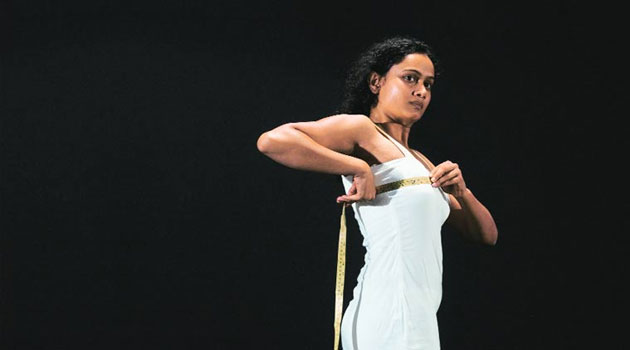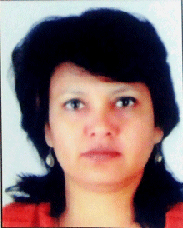By Dipanita Nath | PUBLISHED: 03, Mar 2015, 16:21 pm IST | UPDATED: 03, Mar 2015, 16:21 pm IST

In a non-verbal play titled unSEEN, actor Kalyanee Mulay, 26, enters the stage in a bra and cycling shorts, pulls on a white slip, shaves her legs, measures her body parts, including her tongue, with a tape, and touches herself in an attempt to "tickle and disrupt the conventional cultural association with the female body". The play is based on a letter written by Rabindranath Tagore with reference to activist Pandita Ramabai’s speech in 1891, in which he asserts that nature has made women weaker than men physically and intellectually. One of the most provocative and successful productions on the circuit, unSEEN saw many controversies when it was first staged in 2012.
C Sharp C Blunt arrived a year later. Pallavi MD, 36, emotes a musical smartphone app called Shilpa that audiences can “use”. People suggest a sentence or a line, she asks them to choose the sweetness, pitch, flexibility and sexiness of her voice on a scale of one to 10. Pallavi uses her years of training in classical music to sing as the audience orders, with the added options of simultaneously blinking her eyes, waving her hands, shaking her waist and covering her head with a veil. Audiences love it, and few realise that this is the moment they sit forward and begin to connect the gender dots of the storyline.
Until a few years ago, unSEEN and C Sharp C Blunt would have toured for niche audiences or been tucked away among large, group shows. Instead, in December last year, they were among 14 plays at an exclusive festival of solo theatre. Held for the first time, the Ekaharya Performance Festival in Tripunithura, Kerala, was responding to a recent development — a rejuvenation of solo theatre in India. “The focus has turned to solos as a genre in itself,” says Maya Krishna Rao, the grand dame of solos, whose searing Khol Do, based on a Manto story of a father looking for his daughter, who is raped several times in the chaos of Partition, helped reboot the genre in 1993. At the National School of Drama, Delhi, where Rao was once faculty member, the annual theatre Bharat Rang Mahotsav (BRM) in February, also reflected this change. The school received a record number of solo applications and 10 made the cut.
“Solos have always been a part of the Indian performance tradition, but, I think they were not as validated as group performances and were seen as an alternative to the main. The group ideology dominated during the IPTA years between the ’40s and the ’80s. From the ’90s, the maintenance of the group became difficult. Probably, with liberalisation, individuals began to reach out beyond groups. Now, the number of solos has increased, so looking at them curatorially is an exercise in looking at the development of the individual,” says theatre director Abhilash Pillai, curator of Ekaharya.
In a solo, an actor is alone on stage and aware that every eye in the dim hall full of silhouettes is — and should be — trained on him or her. Most solos are less than an hour in duration but a few are as long as a film. Only the power of conviction will carry the performance through. Delhi-based Mallika Taneja, 31, satirises the obsession with a woman’s appearance by arriving in her undergarments and progressively bundling herself in multiple layers of T-shirts, shorts, dresses, scarves, socks and a helmet before asking, “Kaisi lag rahi hoon main?” in Thoda Dhyaan Se. She describes solos as “one of the benchmarks for testing the mettle of an actor”. Mulay calls it “a wonderful form of personal transformation and self-discovery because, to make this kind of work, one has to be very vulnerable and open”. Pallavi adds that she cannot let her concentration waver “because there is nobody to rescue me on stage”. As performers stretch themselves beyond their strengths and shortcomings, they also push the stage to its limits, making one-person shows both personal and radical.
Even performers who take the traditional path are breaking new ground. Patna-based Ajay Kumar, 40, is attempting to revive katha-gaayan-vaachan, an ancient form in which folk storytellers hold gatherings captive for hours by telling them a story through songs, narration and acting. Apart from traditional stories, he has begun musical recitation of poems by Hindi contemporary poets such as Suryakant Tripathi ‘Nirala’, Raghuvir Sahay, Sarveshwar Dayal Saxenaa, Shrikant Verma and Bharatendu Harishchandra. At BRM, he performed Mayee Ree Main Kaa Se Kahun, Vijaydan Dehta’s tale about a ghost who falls in love with a bride, to houseful crowds. “My art stands between speech and song. When do we switch from talking to singing? When do we start talking again? We turn narrator and, in a blink, a singer. That’s where the fun lies. Once you have mastered this style, you can tell any story,” says Kumar.
Veterans outnumber newcomers on the solo stage. Naseeruddin Shah performs solo in Einstein, Anupam Kher travels through his life, playing himself and the people he came across over the years, in the autobiographical Kuchh Bhi Ho Sakta Hai, and Kolkata-based Sanchayita Bhattacharya channels the spirit of Franca Rame, Italian actor-activist and wife of Dario Fo, in A Woman Alone, the story of a housewife who is a trigger away from murdering the men in her life. Seema Biswas gets under the skin of a widow who is presumed dead and left on a crematorium pyre, only to gain consciousness in the Anuradha Kapur-directed Jeevit ya Mrit.
Another widely performed show is Saag Meat, in which Seema Pahwa cooks the eponymous mutton dish while she chats about her domestic help and, unwittingly, reveals the dark story of abuse. In two years, more than 55 shows of Saag Meat have been held in halls, homes and restaurants, each performance ending with the audience digging into the meat the actor cooks on stage. As solos multiply, it is appropriate — though a coincidence — that the veteran of solo biographies on Tulsidas, Kabir, Vivekananda and Soordas, Shekhar Sen, has been nominated the chairman of the Sangeet Natak Akademi.
Acting schools include solo performances in their curriculum, but a packed hall respects only the astute performer, especially if they are performing multiple characters. “You have to pull out every trick from the hat,” says Taneja, who has acted in large productions such as The Winter’s Tale with the Delhi-based Tadpole Repertory before attempting her audacious Thoda Dhyaan Se. Mulay, on the other hand, collaborated with another expert, director Vishnupad Barve, for unSEEN.
Senior artistes, jokes one director, love solos “because they don’t want to share the money”. It is true that financial investment is less here than in groups. Solos enable actors to travel widely to festivals and shows in metros and Tier-II and III cities as well as outside the country. Aesthetically, too, a solo can trim away the grammar of the proscenium such as properties, amplifiers, microphones and focus lights. One could also joke that all it takes to make a successful solo is two people — one to perform and the other to watch. The venue can vary from a park to a bedsit and, as Kerala-based Vinu Joseph showed, anywhere is good.
Joseph did not act in a hall of the Tripunithura palace where the Ekaharya festival was held. With his body plumped and distorted by balloons, he presented his piece Dr Vikadan, The Theatre Clown as audiences walked in and out of other shows through corridors, around corners and even in the kitchen. “After the massacre of schoolchildren in Peshawar in December, he made a puppet of a child from balloons and performed with it. The bloated puppet didn’t get the shape of the body, it was just a creature that moved between the audience. Sometimes, Joseph would take off on a narrative of violence on children and, at other times, he would stand still like an immobile sculpture. It was non-verbal and very engaging, the children loved him,” says Pillai.
Most solo actors use interactions in which audiences share in the creative process of a play. In Delhi-based Jilmil Hajarika’s To Kill or Not to Kill, audiences get to talk to Medea, the man hater, and Hamlet, the woman-hater, and, in the final scene, as the deranged heroine of Euripedes prepares to kill her husband Jason and children, they become the chorus, crying out in one voice, “Hosh mein aa Medea”.
Will actor ambition and the economic slowdown make solos the dominant form? Or will Indian theatre reflect a coexistence as seen in the Edinburgh Festival where solos and groups draw equal crowds? “Why compare?” asks Pillai, “The important thing is not to sideline solos. After all, if you hear one voice in a group, sometimes you hear only that voice. The group is also necessary, but, for neither to be limited, the equation must change.” Meanwhile, Mulay is preparing another solo for later this year.

by : Priti Prakash
The year 2025 dawned with New Delhi gazing lovingly into the mirror of its own expectations. After a...